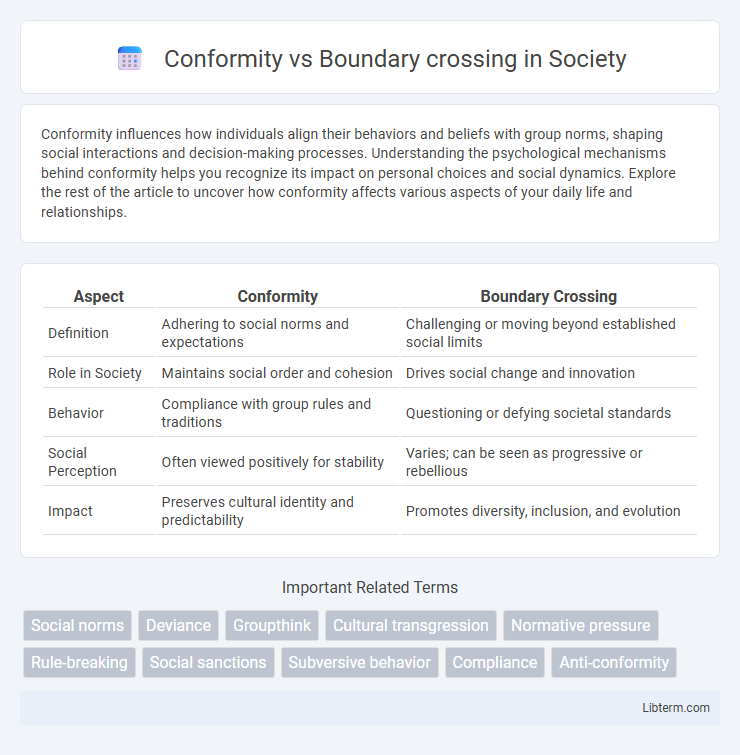Conformity influences how individuals align their behaviors and beliefs with group norms, shaping social interactions and decision-making processes. Understanding the psychological mechanisms behind conformity helps you recognize its impact on personal choices and social dynamics. Explore the rest of the article to uncover how conformity affects various aspects of your daily life and relationships.
Table of Comparison
| Aspect | Conformity | Boundary Crossing |
|---|---|---|
| Definition | Adhering to social norms and expectations | Challenging or moving beyond established social limits |
| Role in Society | Maintains social order and cohesion | Drives social change and innovation |
| Behavior | Compliance with group rules and traditions | Questioning or defying societal standards |
| Social Perception | Often viewed positively for stability | Varies; can be seen as progressive or rebellious |
| Impact | Preserves cultural identity and predictability | Promotes diversity, inclusion, and evolution |
Understanding Conformity: Definition and Key Concepts
Understanding conformity involves recognizing the process through which individuals align their behaviors, beliefs, or attitudes to match group norms or societal expectations. Key concepts include normative influence, where people conform to be liked or accepted, and informational influence, where conformity arises from the desire to make correct decisions based on others' information. Social conformity plays a crucial role in group cohesion and social order, impacting decision-making, behavior modeling, and cultural assimilation.
Boundary Crossing: Challenging the Status Quo
Boundary crossing involves challenging established norms to foster innovation and growth within organizations or communities. This approach encourages individuals to question traditional practices, leading to the development of new ideas and transformative solutions. Embracing boundary crossing can disrupt stagnant systems and drive progress by promoting creative thinking and adaptive change.
Historical Perspectives on Social Conformity
Historical perspectives on social conformity reveal its roots in maintaining social order and group cohesion, with early studies by Solomon Asch demonstrating the power of peer pressure in shaping individual behavior. Emile Durkheim emphasized conformity as essential for social integration and collective conscience in traditional societies. Boundary crossing, contrasting with conformity, challenges established norms by questioning and redefining social limits, often leading to social change through acts of nonconformity and deviance.
Psychological Drivers Behind Conformity
Psychological drivers behind conformity include the innate human need for social acceptance and belonging, which motivates individuals to align their behaviors and beliefs with group norms. Cognitive mechanisms such as informational social influence lead people to conform when uncertain, relying on others as sources of accurate information. Fear of social rejection and desire to avoid conflict also reinforce conformity, even when it involves suppressing personal opinions or crossing personal boundaries to maintain group harmony.
The Role of Culture in Shaping Boundaries
Culture fundamentally shapes how boundaries are perceived and maintained, influencing norms that dictate conformity or boundary crossing within societies. These cultural norms establish what behaviors are deemed acceptable, guiding individuals to conform to shared values or, alternatively, challenge established limits. Variations in cultural contexts result in differing thresholds for boundary crossing, highlighting the dynamic interplay between cultural identity and social regulation.
Benefits and Drawbacks of Conforming
Conforming promotes social harmony and predictability by aligning individual behavior with group norms, which facilitates cooperation and reduces conflict in workplace or community settings. However, excessive conformity can stifle creativity, inhibit personal growth, and lead to groupthink, where critical thinking is compromised for the sake of consensus. Balancing conformity with boundary crossing enables innovation while maintaining social order, highlighting the importance of context in evaluating the benefits and drawbacks of conforming.
Consequences of Crossing Social Boundaries
Crossing social boundaries often results in significant consequences such as social exclusion, loss of trust, and damaged reputations within communities. Individuals who violate established norms may face sanctions ranging from subtle disapproval to formal penalties, impacting both personal relationships and professional opportunities. These consequences highlight the importance of understanding and respecting cultural, organizational, and societal limits to maintain social cohesion and avoid conflict.
Conformity vs. Authentic Self-Expression
Conformity often requires individuals to suppress their authentic self-expression to fit societal norms and expectations, limiting personal creativity and emotional freedom. Authentic self-expression promotes mental well-being by encouraging uniqueness and genuine interactions, which contrast with the homogenizing pressures of conformity. Balancing conformity with authentic self-expression is crucial for psychological health and social integration.
Case Studies: Notable Examples of Boundary Crossing
Case studies of boundary crossing highlight influential examples where individuals or organizations transcend conventional limits to foster innovation. Notable cases include Steve Jobs integrating technology and design at Apple, breaking industry norms to revolutionize consumer electronics. Another example is Malala Yousafzai challenging education boundaries for girls in Pakistan, demonstrating the power of crossing socio-political barriers to achieve social change.
Fostering Healthy Balance Between Conformity and Individuality
Fostering a healthy balance between conformity and individuality requires recognizing the importance of social norms while encouraging personal expression and critical thinking. Emphasizing psychological flexibility allows individuals to adapt to group expectations without losing their unique identity or creativity. Promoting environments that value diversity and open dialogue supports both social cohesion and authentic self-development.
Conformity Infographic

 libterm.com
libterm.com